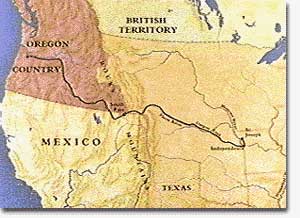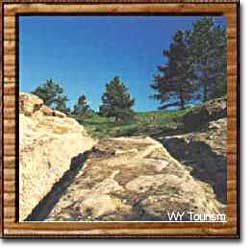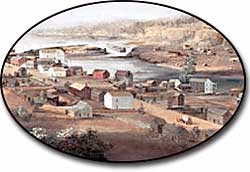29b. 54° 40' or Fight

The southern boundary of the United States with Mexico was not the only western territory under dispute. The Oregon Territory spanned the modern states of Oregon, Idaho, and Washington, as well as the western coast of Canada up to the border of Russian Alaska. Both Great Britain and America claimed the territory. The Treaty of 1818 called for joint occupation of Oregon — a solution that was only temporary. Led by missionaries, American settlers began to outnumber British settlers by the late 1830s. But Britain was not Mexico. Its powerful navy was still the largest in the world. Twice before had Americans taken up arms against their former colonizers at great expense to each side. Prudence would suggest a negotiated settlement, but the spirit of manifest destiny dominated American thought. Yet another great showdown loomed.

Wagon tracks leftover from the Oregon Trail pioneers still crisscross the American midwest.
Oregon fever swept the nation in the 1840s. Thousands of settlers, lured by the lush Willamette Valley headed west on the Oregon Trail. Families in caravans of 20 or 30 braved the elements to reach the distant land. Poor eastern families could not generally make the trip, as outfitting such an expedition was quite expensive. The Conestoga wagon, oxen and supplies comprised most of the cost. The families fought Native Americans at times, but often they received guidance from the western tribes. It took six months of travel at the speed of fifteen miles per day to reach their destination.
|
Friday, May 6th — Pleasant. We have just passed the Mormon graveyard. There is a great number of graves on it. The road is covered with wagons and cattle. Here we passed a train of wagons on their way back, the head man had drowned a few days before, in a river called Elkhorn, while getting some cattle across, and his wife was lying in the wagon quite sick, and children were mourning for a father gone. With sadness and pity I passed those who perhaps a few days before had been well and happy as ourselves. Came 20 miles today. Excerpt from Diary of Mrs. Amelia Stewart Knight, 1853 | ||
In the east, the subject of Oregon was less personal and more political. In 1844 the Democrats nominated James K. Polk, an unknown candidate from Tennessee. It appeared as though the Whig Party candidate, Henry Clay, would win in a landslide. Very few Americans had ever heard the name Polk, but Clay's illustrious career was widely known. However, Polk was an excellent strategist. He tapped into the public mood and realized that manifest destiny was the very issue that could lead him to victory. Polk called for expansion that included Texas, California, and the entire Oregon territory. The northern boundary of Oregon was the latitude line of 54 degrees, 40 minutes. "Fifty-four forty or fight!" was the popular slogan that led Polk to victory against all odds.

Claiming the territory in an election campaign was one thing. Acquiring it from the powerful British was another. Although Polk blustered about obtaining the entire territory from Britain, he was secretly willing to compromise. Trouble was brewing with Mexico in the south. Surely the new nation could ill afford to fight Mexico in the southwest and the British in the northwest simultaneously. Nevertheless, Polk boldly declared to Great Britain that joint occupation would end within one year. The British were confident they could win, but by 1846 they were vastly outnumbered in Oregon by a margin of greater than six to one. In June of that year, Britain proposed splitting Oregon at the 49th parallel. Polk agreed to the compromise, and conflict was avoided.






